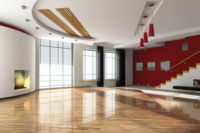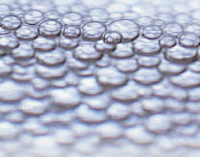
Façade coatings must fulfill various functions. In addition to protecting exterior construction materials against the effects of water, pollutants and chemical attack, the façade should also be aesthetically pleasing. Since most damaging effects require water, which can come from a variety of sources in addition to the exterior surface, well-protected façades should be low water absorbing and water vapor permeable.
A common problem for many façade coatings is their lack of water vapor permeability. When water enters the interface between the coating and the substrate coating, failures occur in the forms of blistering, cracking and peeling. By allowing water to escape these coatings, failures are avoided. In a well-protected façade, absorbed moisture must be allowed to escape into the atmosphere and the coating itself must last as long as possible.
Whether for newly built residential or commercial buildings, or for the repair and preservation of existing buildings, silicone resin emulsion paints and finishes with both mineral and organic-like properties offer two benefits: outstanding water vapor permeability and low water absorption, providing attractive and durable façades.
How do the silicone resins provide these benefits? First, silicones by nature are both inorganic and organic. As such, they are commonly used as adhesion promoters and coupling agents between inorganic and organic materials. In the paint systems, the silicones provide excellent bonding between organic resins and the inorganic fillers in the paint, and also between mineral substrates and the silicone-containing coating system (Figure 1). The silicone resins reinforce like steel reinforcement in concrete.

Generally speaking, highly durable coating systems utilize a primer and a topcoat. It is therefore crucial for the effectiveness and durability of the system to use a high-quality primer. The primer system must be compatible with the topcoat. This is achieved in this coating system with the use of low molecular forms of silicone resins. As for the silicone resins, their inorganic and organic properties again provide water repellency with excellent penetration and adhesion between the mineral-based substrate and the silicone resin-containing paint.


In fact, performance on exterior exposure has been demonstrated to be much greater than that on test fences. Even though the latest silicone resin emulsion paint technologies are far superior to earlier technologies, buildings protected with SREP over 30 years ago continue to show excellent durability and appearances. This performance has led to wide acceptance in Europe, and more recently in Asia. From buildings in northern climates with extreme temperature ranges, including freeze/thaw conditions, to buildings in tropical climates, where heavy rainfall and biological damage from algae and fungus are prevalent, this coating system has provided durable performance over time.
Other important performance benefits have been observed by examining SREP coated buildings over time. The coatings weather well over time, retaining their color due to the strong bonding between pigment and resin. The coatings resist dirt pickup as water that carries dirt into coatings is repelled. Often biological growth is mistaken for dirt — in numerous field examples with both silicone primers and paints, the low water absorption and the inherent resistance of silicones to biological attack works to improve façade appearances.
Another important point about these coatings systems is the ability to paint over them. Both laboratory testing and field experience have demonstrated the recoatability of these systems. This is due to the silicone resin nature of the system, which has much different physical and chemical properties from the elastomeric silicones used in sealants, silicone rubber and other coatings systems. The inherent water repellency of silicone resin emulsion paint coatings is overcome by the low surface tension of coatings that are applied over them. In fact, due to the porous nature of the silicone-based coating, paints applied over them are able to penetrate deeply for good adhesion.


In conclusion, silicone resin emulsions are used in combination with latex emulsion binders to create extremely durable coatings systems, paints, finishes and stuccos. Demonstrated advantages, including low water absorption, high vapor permeability, low dirt pickup, reduced biological growth, recoatability, low VOC emissions and reduced paint disposal, result in real benefits for end users in terms of service life, weathering resistance, cost savings, improved aesthetics, and care for the environment.
For more information on silicone resins, contact Wacker Silicones Corp., 3301 Sutton Road, Adrian, MI 49221; phone 800/248.0063; fax 517/264.8620; visit www.wackersilicones.com; e-mail bettersolu tions@wackersilicones.com; or.



Report Abusive Comment